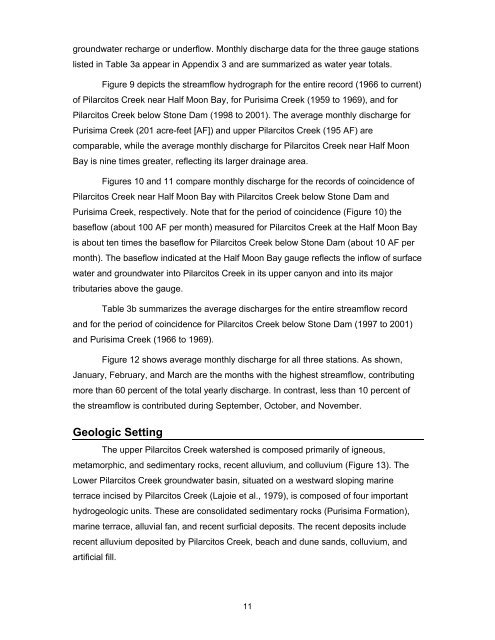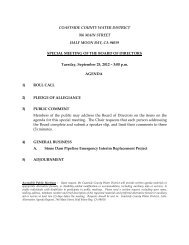Lower Pilarcitos Creek Groundwater Basin Study - Coastside ...
Lower Pilarcitos Creek Groundwater Basin Study - Coastside ...
Lower Pilarcitos Creek Groundwater Basin Study - Coastside ...
Create successful ePaper yourself
Turn your PDF publications into a flip-book with our unique Google optimized e-Paper software.
groundwater recharge or underflow. Monthly discharge data for the three gauge stations<br />
listed in Table 3a appear in Appendix 3 and are summarized as water year totals.<br />
Figure 9 depicts the streamflow hydrograph for the entire record (1966 to current)<br />
of <strong>Pilarcitos</strong> <strong>Creek</strong> near Half Moon Bay, for Purisima <strong>Creek</strong> (1959 to 1969), and for<br />
<strong>Pilarcitos</strong> <strong>Creek</strong> below Stone Dam (1998 to 2001). The average monthly discharge for<br />
Purisima <strong>Creek</strong> (201 acre-feet [AF]) and upper <strong>Pilarcitos</strong> <strong>Creek</strong> (195 AF) are<br />
comparable, while the average monthly discharge for <strong>Pilarcitos</strong> <strong>Creek</strong> near Half Moon<br />
Bay is nine times greater, reflecting its larger drainage area.<br />
Figures 10 and 11 compare monthly discharge for the records of coincidence of<br />
<strong>Pilarcitos</strong> <strong>Creek</strong> near Half Moon Bay with <strong>Pilarcitos</strong> <strong>Creek</strong> below Stone Dam and<br />
Purisima <strong>Creek</strong>, respectively. Note that for the period of coincidence (Figure 10) the<br />
baseflow (about 100 AF per month) measured for <strong>Pilarcitos</strong> <strong>Creek</strong> at the Half Moon Bay<br />
is about ten times the baseflow for <strong>Pilarcitos</strong> <strong>Creek</strong> below Stone Dam (about 10 AF per<br />
month). The baseflow indicated at the Half Moon Bay gauge reflects the inflow of surface<br />
water and groundwater into <strong>Pilarcitos</strong> <strong>Creek</strong> in its upper canyon and into its major<br />
tributaries above the gauge.<br />
Table 3b summarizes the average discharges for the entire streamflow record<br />
and for the period of coincidence for <strong>Pilarcitos</strong> <strong>Creek</strong> below Stone Dam (1997 to 2001)<br />
and Purisima <strong>Creek</strong> (1966 to 1969).<br />
Figure 12 shows average monthly discharge for all three stations. As shown,<br />
January, February, and March are the months with the highest streamflow, contributing<br />
more than 60 percent of the total yearly discharge. In contrast, less than 10 percent of<br />
the streamflow is contributed during September, October, and November.<br />
Geologic Setting<br />
The upper <strong>Pilarcitos</strong> <strong>Creek</strong> watershed is composed primarily of igneous,<br />
metamorphic, and sedimentary rocks, recent alluvium, and colluvium (Figure 13). The<br />
<strong>Lower</strong> <strong>Pilarcitos</strong> <strong>Creek</strong> groundwater basin, situated on a westward sloping marine<br />
terrace incised by <strong>Pilarcitos</strong> <strong>Creek</strong> (Lajoie et al., 1979), is composed of four important<br />
hydrogeologic units. These are consolidated sedimentary rocks (Purisima Formation),<br />
marine terrace, alluvial fan, and recent surficial deposits. The recent deposits include<br />
recent alluvium deposited by <strong>Pilarcitos</strong> <strong>Creek</strong>, beach and dune sands, colluvium, and<br />
artificial fill.<br />
11



